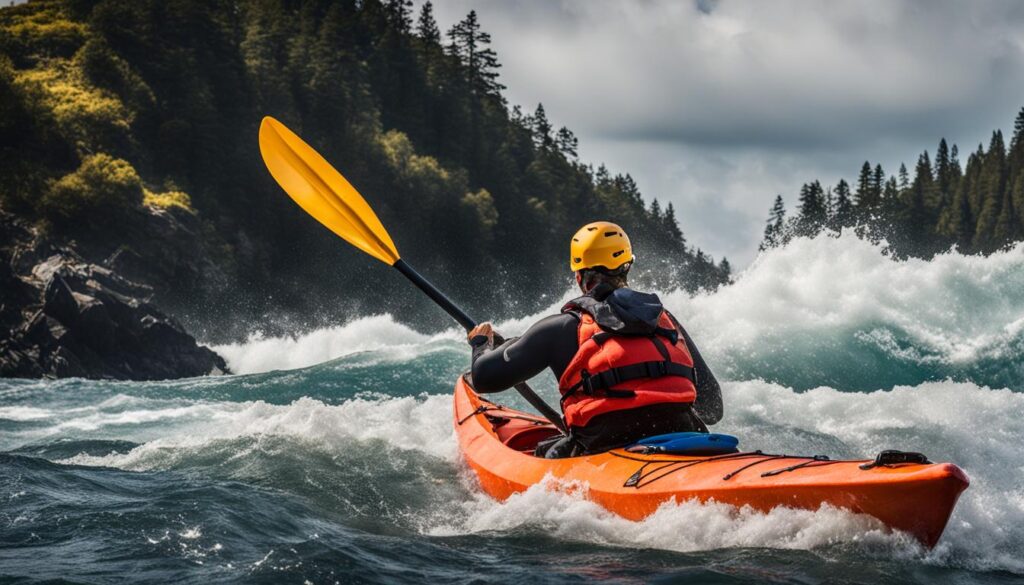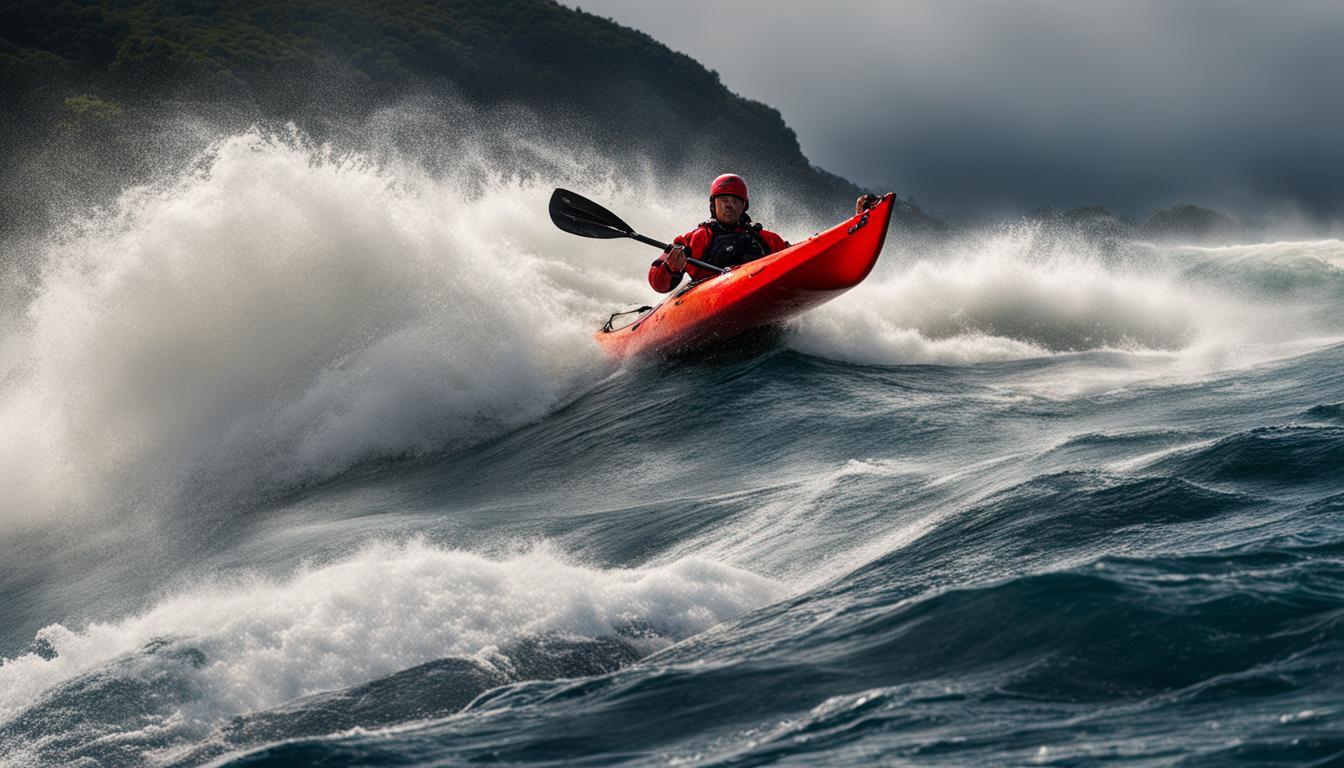Sea kayaking in ocean surf can be an exciting and rewarding experience. To navigate the waves successfully, it is important to have the necessary skills and gear. Being comfortable with wet exits, knowing rescue techniques, and being able to handle your kayak with paddle strokes and body mechanics are essential. Dressing appropriately for the conditions, including wearing a dry suit and a proper-fitting helmet, is also important. It is recommended to paddle with a group and seek formal instruction or advice from experienced paddlers. Safety considerations, such as having a pre-float safety plan and familiarizing yourself with the surf area, are crucial. Understanding wave formation and knowing which ocean waves to start with can help in choosing the right conditions for your skill level. Selecting the best place to launch and learning the necessary skills to navigate the surf zone are also essential for handling kayak waves effectively.
Key Takeaways:
- Handling kayak waves requires necessary skills and gear
- Dressing appropriately and using safety precautions are crucial in ocean surf
- Seek formal instruction and advice from experienced paddlers
- Understand wave formation and choose the right conditions for your skill level
- Learn the necessary skills to navigate the surf zone effectively
Continue reading to learn about the basic skills and gear you need for kayaking in rough waters.
The Basic Skills You Need
To effectively kayak in ocean surf, it is important to have a solid foundation of skills. Being comfortable with wet exits and knowing both assisted and self-rescues are necessary for handling potential capsizes. Additionally, being able to handle your kayak with paddle strokes and body mechanics, such as edging and leaning, will help in navigating the waves. Embracing the swims and being prepared to get wet and go upside down is part of the fun. Paddling with a group of likeminded paddlers is important for safety, as well as seeking formal instruction or advice from experienced paddlers.
Developing proper paddle strokes is crucial when navigating kayak waves. The forward stroke, sweep stroke, and draw stroke will help you control your kayak and maintain stability. The forward stroke is the basic paddling technique, propelling you forward. The sweep stroke is used to turn the kayak, while the draw stroke allows you to move the kayak sideways. It is important to practice these strokes in calm waters before attempting them in ocean surf.
Body mechanics play a significant role in handling kayak waves. Edging your kayak involves tilting it to one side, allowing you to turn more efficiently and maintain balance. Leaning your body in the direction you want to go can help you stay stable and in control. It is recommended to practice these techniques in calm waters to become comfortable before venturing into rougher surf zones.
“The waves of the sea help me get back to me. It is not a leisure activity, but a way of getting in touch with the rhythm of the earth.” – Unknown
The Basic Gear You Need
Kayaking in rough waters requires the right gear to ensure your safety and comfort. Here are some essential items you’ll need:
Dry Suit
 A dry suit is recommended for kayaking in hypothermic water temperatures. It provides thermal protection and keeps you dry even if you capsize or come in contact with cold water. Make sure the dry suit fits properly and is in good condition before heading out into rough water.
A dry suit is recommended for kayaking in hypothermic water temperatures. It provides thermal protection and keeps you dry even if you capsize or come in contact with cold water. Make sure the dry suit fits properly and is in good condition before heading out into rough water.
Helmet
A proper-fitting helmet is crucial when kayaking in the rough surf environment. It protects your head from potential injuries caused by rocks, waves, or your kayak. Look for a helmet specifically designed for water sports, with adjustable straps for a secure fit.
Gear Security
When kayaking in the surf zone, it’s important to secure your gear properly to avoid losing it in the water. Use bungee cords, deck bags, or dry bags to keep your essentials, such as a phone, snacks, or spare paddle, within reach and securely attached to your kayak. Consider using a leash to keep your paddle attached to your kayak, ensuring it doesn’t float away if you let go.
Personal Flotation Device (PFD)
Always wear a personal flotation device (PFD) when kayaking in rough waters. Choose a PFD specifically designed for water sports with a snug fit and adjustable straps. Make sure it’s approved by relevant safety standards and well-maintained. Your PFD should enable easy movement and not restrict your paddling strokes or range of motion.
Footwear
When kayaking in rough waters, it’s essential to wear the right footwear to protect your feet and provide grip on wet surfaces. Neoprene booties or water shoes with non-slip soles are ideal options. Avoid wearing sandals or flip-flops as they may come off in the water or hinder your ability to maneuver your kayak effectively.
Other Considerations
In addition to the gear mentioned above, consider carrying a whistle or signaling device to attract attention if needed. It’s also a good idea to have a knife or multi-tool for emergency situations. Remember to regularly inspect and maintain your gear to ensure it’s in proper working condition before each kayaking expedition.
| Essential Gear for Kayaking in Rough Waters |
|---|
| Dry Suit |
| Helmet |
| Gear Security |
| Personal Flotation Device (PFD) |
| Footwear |
Kayaking in Rough Waters: Safety Considerations
When venturing into the thrill of kayaking in ocean surf, it is crucial to prioritize safety. The rough waters and dynamic surf zones present unique challenges that require preparation and caution. By understanding and implementing key safety considerations, you can ensure a secure and enjoyable kayaking experience.
First and foremost, creating a pre-float safety plan is essential. Discussing expectations, emergency procedures, and rescue techniques with your group before embarking on your adventure will help everyone stay prepared and coordinated in the event of a capsize or the need for assistance. This proactive approach ensures that all members of the group are accounted for and can effectively handle potential emergencies.
Familiarizing yourself with the specific surf area is critical. Take the time to study the characteristics of the beach, including potential hazards such as rocky areas or underwater obstacles. This knowledge will help you navigate the surf zone safely and avoid accidents. Additionally, staying updated on surf conditions through reliable sources and understanding your skill level’s limitations will prevent you from kayaking in conditions that may be too challenging for you.
“Safety should always be the top priority when kayaking in rough waters. By having a solid pre-float plan and being aware of the surf area’s hazards, you can enjoy the thrill of kayaking in the surf while minimizing risks.” – Experienced kayaker
Table: Essential Safety Considerations for Kayaking in Rough Waters
| Safety Considerations | Description |
|---|---|
| Pre-float safety plan | Create a plan with your group, outlining expectations, emergency procedures, and rescue techniques. |
| Familiarize with the surf area | Study the beach characteristics, potential hazards, and surf zone dynamics to navigate safely. |
| Stay updated on surf conditions | Check reliable sources for surf forecasts and avoid kayaking in conditions beyond your skill level. |
Which Ocean Waves to Start With
When it comes to sea kayaking in heavy waves, choosing the right waves to start with is crucial. As a beginner, you want to avoid steep, dumping waves that can be challenging to handle. Instead, look for waves that spill onto the beach. These waves are easier to manage and provide an opportunity for you to develop your boat-handling skills. Waves in the range of 2-3 feet are ideal for beginners to practice in, as they offer a good balance of size and manageable intensity.
To make an informed decision about which waves to start with, it’s essential to understand how waves break on the shore. Waves can break in different ways, such as plunging, spilling, or surging, depending on the slope of the beach and the depth of the water. Familiarize yourself with the beach characteristics of your chosen surf spot. Sandy beaches with gentle slopes are generally more forgiving and provide a better learning environment for beginners. Rocky areas can create hazardous conditions and should be avoided until you have more experience and confidence in handling your kayak.
Remember, safety should always be your top priority. Before venturing out into heavy waves, assess your skill level honestly. Seek guidance and advice from experienced paddlers who can provide valuable insights and tips for navigating the surf. Consider taking formal instruction to learn proper technique and safety protocols. With proper preparation and practice, you can develop the surfing skills necessary to enjoy the exhilaration of sea kayaking in heavy waves.

| Wave Type | Description |
|---|---|
| Plunging | Steep waves that break abruptly and forcefully, often creating a hollow tube |
| Spilling | Gentle, rolling waves that break gradually and spill onto the beach |
| Surging | Powerful waves with no distinct breaking point, often found in shallow water |
Conclusion
Kayaking in rough waters and tackling ocean surf can provide sea kayakers with an exhilarating and unforgettable experience. By equipping yourself with the necessary skills, gear, and safety considerations, you can confidently navigate the waves and enjoy the thrill of sea kayak surf techniques.
Starting with the right waves for your skill level is crucial. Choose waves that spill onto the beach and avoid steep, dumping waves, especially if you’re a beginner. Practicing in a controlled environment and familiarizing yourself with wave formation and beach characteristics will help you develop your boat-handling skills.
Remember to prioritize safety at all times. Have a pre-float safety plan, paddle with a group, and stay updated on surf conditions. Seeking formal instruction or advice from experienced paddlers is invaluable. Continuously learn and improve your kayaking skills to ensure a safe and enjoyable experience in rough waters.
So, gear up, hop in your kayak, and embrace the excitement of kayaking in ocean surf. With practice, experience, and the right mindset, you’ll be riding the waves like a pro in no time!
FAQ
What skills do I need to effectively kayak in ocean surf?
It is important to be comfortable with wet exits, know rescue techniques, and be able to handle your kayak with paddle strokes and body mechanics.
What gear do I need for kayaking in ocean surf?
It is recommended to wear a dry suit and a proper-fitting helmet. Dressing appropriately for the conditions is also important.
How can I ensure safety when kayaking in ocean surf?
It is important to have a pre-float safety plan, paddle with a group, and familiarize yourself with the surf area. Seeking formal instruction or advice from experienced paddlers is also recommended.
What kind of ocean waves should I start with as a beginner?
Waves that spill onto the beach are easier to manage and provide an opportunity to develop boat-handling skills. Waves in the 2-3 foot range are ideal for beginners to practice in.
How can I improve my kayaking skills in ocean surf?
By practicing in a controlled environment and starting with the right waves for your skill level, you can develop your boat-handling skills and begin to surf waves confidently.





